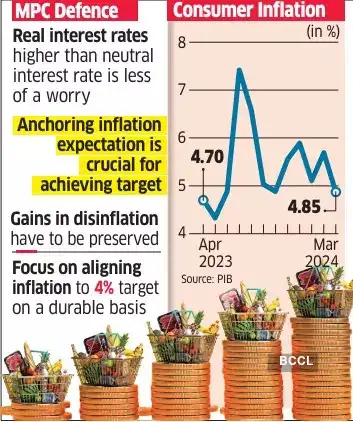In the last monetary policy committee (MPC) review on rates earlier this month, the panel decided to keep the policy rates unchanged, stretching the status quo on the cost of funds to at least 16 months.
External panel member Jayanth Varma voted for a change in the panel’s stance to “neutral” from “withdrawal of accommodation”, while all the members voted for a pause in the policy rates at 6.5%. Barring Varma, the other MPC members backed the move to continue with the current stance.
Headline consumer inflation has been steadily falling since July 2023, after touching a peak of 7.6%. It is now closer to the legally mandated target of 4%, with a 4.8% print in March.

Still, members of the rate-setting panel need to be convinced that the slide would continue and that inflation is brought down, durably, within the limits set by the law.“The MPC minutes showed that members who have been hawkish earlier likely dialled up their hawkishness a notch, advocating patience on inflation and uncertainties amid robust growth,” said Shreya Sodhani, regional economist, Barclays. “With the MPC seeing no urgency to cut rates, we doubt the RBI will front-run the US Federal Reserve in pivoting. We, therefore, now expect rate cuts from Q4 in 2024.”HIGHER REAL RATES
Although real interest rates are higher than earlier, sustained growth has mitigated concerns of the likely adverse impact of rates on demand and the economy.Corporate profits and growth are robust: The economy averaged around 8% in the first three quarters, noted the policymakers. Exports and rural consumption are recovering, while bank credit growth is the highest in about a decade. “A slight slackening in momentum, especially in categories with sharp growth, is desirable since credit spikes create risk,” said external member Ashima Goyal. “India’s relatively low credit/GDP ratio has to rise, but it is best if this happens gradually so that it is sustainable.” The minutes show policymakers’ focus on ensuring stability, especially against the backdrop of potential geopolitical risks that could multiply in the aftermath of the West Asian skirmishes.
“In the current situation of many types of uncertainty, however, maintaining stability must have priority. Therefore, I continue to vote for a pause in the repo rate and for an unchanged stance,” Goyal said.
To be sure, the minutes were written prior to the latest escalation involving Iran and Israel.
“Some global food prices are firming up in an environment of rising input costs and supply chain pressures,” said deputy governor Michael Patra. “The headroom provided by the steady core disinflation and fuel price deflation does not assure a faster alignment of the headline with the target.”
External member Varma, however, sounded cautious on the potential adverse impact of higher real rates. “The fact that economic growth in 2024-25 is projected to slow by over half a percent relative to 2023-24 is a reminder that high interest rates entail a growth sacrifice,” said Varma. “Monetary policy should try to reduce this sacrifice while ensuring that inflation remains within the band and glides toward the target.”










